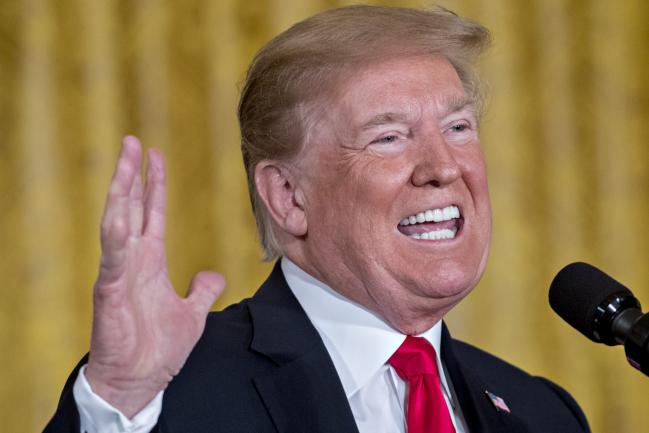(Bloomberg) -- The world economy lurched closer to an all-out trade war as the Trump administration accused China of threatening U.S. economic interests and as the European Union made good on its threat to hit American goods with retaliatory tariffs.
A scathing report, posted late Tuesday by the White House, blamed Beijing for hijacking intellectual property and pursuing destructive industrial policies, saying the nation’s spectacular economic growth “has been achieved in significant part through aggressive acts, policies and practices that fall outside of global norms and rules.”
“Given the size of China’s economy and the extent of its market-distorting policies, China’s economic aggression now threatens not only the U.S. economy, but also the global economy as a whole,” according to the 35-page document.
The White House report came out just before the EU triggered the first phase of retaliation against the U.S. over its metal-import tariffs, approving a 25 percent duty on 2.8 billion euros ($3.2 billion) of U.S. products including Harley-Davidson Inc (NYSE:HOG). motorcycles and Levi Strauss & Co. jeans. It opens up a second contentious trade front for Trump, who ordered U.S. officials on Monday to consider imposing tariffs on an additional $200 billion in Chinese imports -- with another $200 billion to be added if Beijing retaliates.
Economic Fallout
The EU countermeasures will hit U.S. consumer, agricultural and steel products in many key Republican constituencies, putting pressure on Trump ahead of crucial midterm elections in November.
“We did not want to be in this position,” European Trade Commissioner Cecilia Malmstrom said in a statement on Wednesday. “However, the unilateral and unjustified decision of the U.S. to impose steel and aluminum tariffs on the EU means that we are left with no other choice.”
Despite the brewing dispute, U.S. futures advanced, tracking gains across Asia and Europe. Every sector rose in the Stoxx Europe 600 Index, which jumped following three days of losses. The Stoxx Europe 600 Index rose 0.6 percent as of 7:16 a.m. New York time, while futures on the S&P 500 Index gained 0.2 percent.
On the other side of the Pacific, economists are starting to run the numbers on what kind of dent to growth such actions will have on China’s economy. Bloomberg Economics’ Tom Orlik and Fielding Chen write that the impact of decreased exports and lower manufacturing investment could mean a 0.5 percent blow to gross domestic product.
A pull back in Chinese investment in the U.S. is already evident. Research from Rhodium Group LLC showed Chinese companies completed acquisitions and greenfield investments worth $1.8 billion in the first half, representing a drop of more than 90 percent from the same period in 2017 and the lowest level in seven years.
U.S. Boom
The trade skirmishes are not holding back the U.S. economy just yet, which is booming this quarter as tax cuts power consumers and businesses. Still, as risks to that outlook mount, economists are pointing to higher checkout prices on a range of tech, apparel and household goods for U.S. consumers should Trump follow through with his latest tariff threats.
Just last week, Trump unveiled plans to implement previously announced tariffs on $50 billion in primarily industrial goods. China has said it will match those levies in kind, and has already responded to earlier duties on metals imports.
The U.S. government has long complained that China obtains American intellectual property and technology through underhanded means, and the White House report restated many of those concerns, including about hacking, physical theft of trade secrets and evasion of export control laws.
Physical Theft
The Chinese government says that it is working to improve intellectual property protection. Companies surveyed by the European Union Chamber of Commerce do see some improvement, though a slim majority say protection of intellectual property in China is still inadequate.
“Physical theft through economic espionage by company insiders or others who have trusted access to trade secrets and confidential business information provides China with a significant means to acquire U.S. technologies and intellectual property," the White House report charges.
The report, titled “How China’s Economic Aggression Threatens the Technologies and Intellectual Property of the United States and the World,” does not make any specific policy recommendations. Yet it codifies some of the administration’s arguments for a more aggressive stance toward China over trade.
Besides the volleys of tariffs on goods from China, the Trump administration is also considering measures that would restrict Chinese investment in sensitive American technology.
Ownership Restrictions
The report also accuses China of openly protecting domestic industries from competition and imports through tariffs, regulation and restrictions on foreign ownership. It also says China offers financial support to bolster its exports to foreign markets.
It adds that Chinese state-owned companies pose an additional threat to overseas firms, given their close ties to the Beijing government.
The government itself dominates many industries and plays an enormous role in investment decisions and strategy. For instance, the report says, until 2014, state-supported foreign investment funds were directed toward acquiring natural resources. Now, that focus has shifted to technology.
The U.S. imported $505 billion of goods from China last year and exported about $130 billion, leaving a 2017 trade deficit of $376 billion, according to U.S. government figures.
